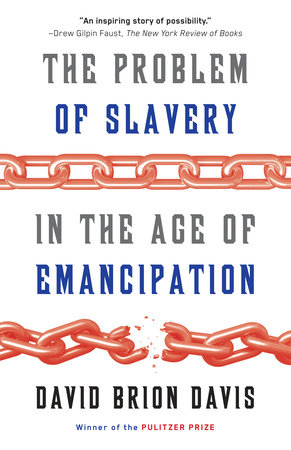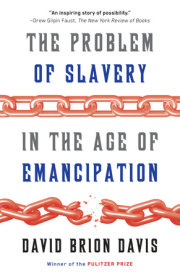1
Some Meanings of Slavery and Emancipation: Dehumanization, Animalization, and Free Soil
God’s first blunder: Man didn’t find the animals amusing,—he dominated them, and—didn’t even want to be an “animal.” —Nietzsche,
Der Antichrist
The Meaning of Animalization, Part I
Traveling through the South in 1856, the famous journalist and landscape designer Frederick Law Olmsted remarked to a white overseer that it must be disagreeable to punish slaves the way he did. The overseer replied, “Why, sir, I wouldn’t mind killing a nigger more than I would a dog.”
Does this mean that blacks who were treated like animals were literally seen as “only animals,” or as an entirely different species from humans? The answer is clearly no, except perhaps in some extreme cases and for very brief periods of time—as for example in the post-emancipation lynching era, when many black men accused of raping white women were hanged or tortured, dismembered, and burned alive, occasionally before immense cheering crowds of Southern white men, women, and children.
Degradation and insult are reinforced every day when people call other people curs, pigs, swine, apes, bitches, and sons of bitches, terms which momentarily dehumanize one party while enhancing the “non-animal” superiority of the other. But animalization can cover a spectrum from superficial insult to the justification of slavery and on to lynching and genocide.
Thus the use of such animal metaphors as lice, vermin, microbes, and cockroaches, as in the Nazi Holocaust, lowers the process to a different level, justifying the complete extermination of an impure enemy group that supposedly threatens the basic health of society and therefore has no right to exist. I am mainly concerned here with the psychological and linguistic process, as a way of dealing with the question of whether humans who were treated like animals were ever literally seen as “only animals,” since a discussion of diverse motives would lead us far astray. The world had never seen such an extreme and systematic engine of dehumanization as the Nazi propaganda machine, epitomized by Joseph Goebbels’s assertion in an early speech (March 7, 1942) that “It is a life-or-death struggle between the Aryan race and the Jewish microbe. No other government and no other regime would have been able to muster the strength to find a general solution to this issue.” Nearly a year later, SS Reichsführer Heinrich Himmler would expand the point in a speech to SS officers:
Antisemitism is exactly the same as delousing. Getting rid of lice is not a question of ideology. It is a matter of cleanliness. In just the same way, antisemitism, for us, has not been a question of ideology, but a matter of cleanliness, which now will soon have been dealt with. We shall soon be deloused. We have only 20,000 lice left, and then the matter is finished within the whole of Germany.
Given the Nazi example, it is worth noting that the antipode of this animalizing can be seen in a universal tendency to project our potentiality for self-transcendence, freedom, and striving for perfection onto images of kings, dictators, demagogues, and cultural heroes of various kinds. This form of idolatry, which ancient Judaism fortunately singled out as the most dangerous sin facing humanity, can also appear in various kinds of narcissism and egocentrism, as when an individual imagines that he is godlike and free from all taint of finitude and corruption.
There is actually a long history to the links between animalization and genocide or ethnic cleansing, and the formula by no means ended with the Nazis. In 1994, when the Hutu slaughtered some 800,000 Tutsi neighbors in Rwanda, the victims were repeatedly likened to
inyenizi, or cockroaches.
But were Jews and Tutsis truly seen as nonhumans, as the actual equivalent of microbes, lice, or cockroaches? Given the appalling realities of mass murder, we are intuitively inclined to think yes. Why else would Himmler try to persuade SS officers that their actions would be exactly the same as delousing? Fortunately, philosopher Kwame Anthony Appiah has insightfully clarified this issue as his discussion of ethics moves from social hierarchy to insiders/outsiders and on to genocidal massacres. In accounting for genocide, “the familiar answer” presumes that members of some outgroup are not considered “human at all.” Yet that “doesn’t explain the immense cruelty—the abominable cruelty,” which is not evident even in the extermination of pests. As Appiah then reasons:
The persecutors may liken the objects of their enmity to cockroaches or germs, but they acknowledge their victim’s humanity in the very act of humiliating, stigmatizing, reviling, and torturing them. Such treatment—and the voluble justifications the persecutors invariably offer for such treatment—is reserved for creatures we recognize to have intentions and desires and projects.
Appiah adds in an endnote that the victimizers always “tell you why their victims—Jews or Aztecs or Tutsi—deserve what’s being done to them.” That was emphatically true of the Nazis, who pictured the Jews not only as an active global threat to civilization throughout history, but in World War II as the hidden conspiratorial force behind both their Soviet and Western enemies. Clearly this retention of a human element fails to make animalization more humane. Quite the contrary.
At this point it should be clear that “dehumanization” means the eradication not of human
identity but of those elements of humanity that evoke respect and empathy and convey a sense of dignity. Dehumanization means the debasement of a human, often the reduction to the status of an “animalized human,” a person who exemplifies the so-called animal traits and who lacks the moral and rational capacities that humans esteem. As Appiah implies, this extreme dehumanization deprives the victims even of the kind of sympathy and connectedness often given to Alzheimer patients or those in a coma.
I would only add that since the victims of this process are perceived as “animalized humans,” this double consciousness would probably involve a contradictory shifting back and forth in the recognition of humanity. When Henry Smith, an African American accused of rape, was tortured and killed in 1893 before a Texas mob of some ten thousand whites, many in the crowd no doubt saw him momentarily as “nothing but an animal” as they watched hot irons being pressed on his bare feet and tongue and then into his eyes, and heard him emit “a cry that echoed over the prairie like the wail of a wild animal.” Conversely, we have reports of German soldiers who momentarily recognized the true humanity of individual Jews as they were herded toward the gas chambers.
In any event, the creation of “animalized humans” can produce a mental state in the victimizers and spectators that disconnects the neural sources of human identification, empathy, and compassion, the very basis for the Golden Rule and all human ethics. In extreme cases, this means the ability to engage in torture or extermination without a qualm. But the focus on extreme cases can obscure the fact, emphasized by David Livingstone Smith, that “we are all potential dehumanizers, just as we are potential objects of dehumanization.” No doubt many situations arise, especially in war, where people kill or inflict pain without misgivings and without any explicit animalization. But the victims must still be
dehumanized in similar ways. And animalization, which also appears in such group differentiations as class, caste, and ethnicity, as well as race, clearly makes the process easier for large collective groups.
One explanation, as already suggested, involves the projection on victims or on groups such as slaves of an exaggerated version of the so-called animal traits that all humans share and often fear and repress. This psychological process deprives the dehumanized of those redeeming rational and spiritual qualities that give humans a sense of pride, of dignity, of being made in the image of God. At the same time, the projection enables the victimizers to become almost psychological parasites, whose self-image is immeasurably enhanced by the dramatic contrast with the degraded and dehumanized “Other.” But why have we humans been so concerned with our “animality,” and what is the ultimate source of this desire to animalize other humans—apart from the quite diverse motives of slaveholders, white supremacists, and Nazis? Here I would turn to Reinhold Niebuhr’s view of the core of human “distinctiveness,” as opposed to other animals, in the fear, self-doubt, anxiety, and even pride and confidence generated by the dilemma of finitude and freedom. The dilemma that prompts us to ask, “Who am I?” “Why am I here?” “What is it all about?” As Niebuhr remarks, while surveying the ways we distinguish the self from the totality of the world, “The vantage point from which man judges his insignificance is a rather significant vantage point.” If one samples some typical quotations on the human condition, we see a single answer in the tension between our sense of our existential animal finitude (evoked by our discovery in childhood that we are certain to die) and our capacity for self-reflection, for making ourselves our own object. Countless poets and philosophers have agreed with Charles Caleb Colton (1780–1830): “Man is an embodied paradox, a bundle of contradictions.”
As expressed by the great French Renaissance essayist Montaigne, “Man sees himself lodged here in the mud and filth of the world, nailed and fastened to the most lifeless and stagnant part of the universe, in the lowest story of the house, at the furthest distance from the vault of Heaven, with the vilest animals; and yet, in his imagination, he places himself above the circle of the moon, and brings Heaven under his feet.” Or according to Edward Tyson, a founder of comparative anatomy whose dissection of a chimpanzee in 1698 led him to the view that “
Man is part a
Brute, part an
Angel; and is that
Link in the Creation, that joyns them both together.” Or Edward Young, an eighteenth-century religious poet much favored by the later British abolitionists: “
Helpless Immortal! Insect
infinite! / A worm! a God! I tremble at myself, / And in myself am lost! At home a stranger.” And Lord Byron, first in Sardanapalus: “I am the very slave of circumstance/ And impulse—borne away with every breath! / Misplaced upon the throne—misplaced in life. / I know not what I could have been, / but feel I am not what I should be—let it end.”
But then, in Byron’s Sonnet to Chillon: “Eternal spirit of the chainless mind! / Brightest in dungeons, Liberty! thou art, / For there thy habitation is the heart, / The heart which love of thee alone can bind.”
When I think of myself wholly in terms of my eating, sleeping, urinating, defecating, cutting toenails (claws), scratching an itch, aging and dying, there can be no question that I am a finite mammal. This exercise, which runs against the grain of a lifetime of “civilizing” and self-idealizing, requires some concentrated effort. But as we define ourselves as rational animals,
Homo sapiens, we continue to marvel over our amazing capacity for self-reflection and rational analysis—for viewing ourselves from a vantage point outside the self, for analyzing our own introspection, and for imagining what it would be like to be someone else, including their own imaginings, even a slave or animal. The 100 billion neurons in our brains enable us even to study and understand
their own actions.
Much human behavior is driven not by simple desires for food, money, sex, and security, but by our need to respond to this paradoxical nature. According to Niebuhr’s classic analysis, the anxiety generated by this paradoxical condition can lead to a denial of our capacity for rationality and self-transcendence, in the sin of sensuality; or, far worse, to a denial of our animality itself, the sin of pride. Animalizing other people is clearly an expression of the sin of pride and was long encouraged, as we will see, by the constant ubiquity and interaction with domesticated animals, as well as by the sharp conceptual division between humans and animals imposed by Western culture.
The psychological mechanism of animalization has been so deeply implanted in white culture, with respect to African Americans, that most white Americans have been unaware of their usually unconscious complicity as well as the significant benefits they have reaped from their “transcendent whiteness.” Especially during the period of racial slavery, the process of animalizing blacks enhanced the whites’ sense of being a rational, self-disciplined, and ambitious people, closely attuned to their long-term best interests. Racism became the systematic way of institutionalizing and justifying the individual white’s projection of an “animal Id” upon blacks. It took the form of an intellectual theory or ideology, cloaked in science, as well as actions and behavior legitimated by laws, customs, and social structure.
As I wrote in a review of Winthrop D. Jordan’s landmark book
White Over Black, “The counter-image of the Negro became the living embodiment of what transplanted Europeans must never allow themselves to become.” This parasitic relationship gave special force to the whites’ sense of historical mission, the “American Dream” of overcoming the limits and boundaries of past history. But as I briefly explore later, a long succession of African American writers, beginning in the eighteenth century and including even Barack Obama, have conveyed the deeply felt effects of this process on individual and collective black self-esteem.
Yet the animalization of black slaves obviously differed markedly from that of groups in danger of genocide. For one thing, slaves were valuable as chattel property and as investments, and in nineteenth-century America their value soared as they became increasingly important to the economy. Far from being in danger of extermination, the lives of slaves were at least legally protected by state laws and interpretations of common law that ruled that the murder of a slave was a crime punishable by death.
But if state laws and courts repeatedly recognized the humanity of slaves, Thomas Jefferson was far from being alone in fearing an eventual war between the races, a war that many whites predicted would end in the extermination of all “Negroes.” And the related subject of black colonization, which had immense theoretical support among the American antebellum white population, promised an eventual removal of the black population by “peaceful means”—an option that even Hermann Göring and some other Nazi leaders favored for the Jews before World War II and “the final solution.”
Finally, as we have seen, the populist lynching of blacks began to reach epic levels in the 1880s and ’90s. The widespread acceptance of scientific racism, a central prop for Jim Crow segregation and white supremacy, reinforced the traditional fear of sexual contamination, through rape or intermarriage—the invasion of the black Id, a reprisal of all the animalistic traits that had been projected on blacks to achieve white purity. In 1897, Rebecca Latimer Felton, a prominent Georgia feminist, journalist, and eventually the first woman to become a U.S. senator, aroused national attention with a near hysterical speech on the peril of black rapists: “[I]f it takes lynching to protect woman’s dearest possession from drunken, ravening human beasts,” she cried, “then I say lynch a thousand [blacks] a week if it becomes necessary.” Later, emphasizing the “moral retrogression” of blacks since the days of slavery, Felton accused the “promoters of Negro equality” of preparing the way for an imminent “revolutionary uprising” that “will either exterminate the blacks or force the white citizens to leave the country.” Fortunately, such extremists never came close to shaping federal policies, but it is significant that at the turn of the twentieth century the Chief Statistician of the U.S. Census, Professor Walter Francis Willcox, and other prominent statisticians, happily predicted the gradual extinction of the Negro race.
Copyright © 2014 by David Brion Davis. All rights reserved. No part of this excerpt may be reproduced or reprinted without permission in writing from the publisher.





